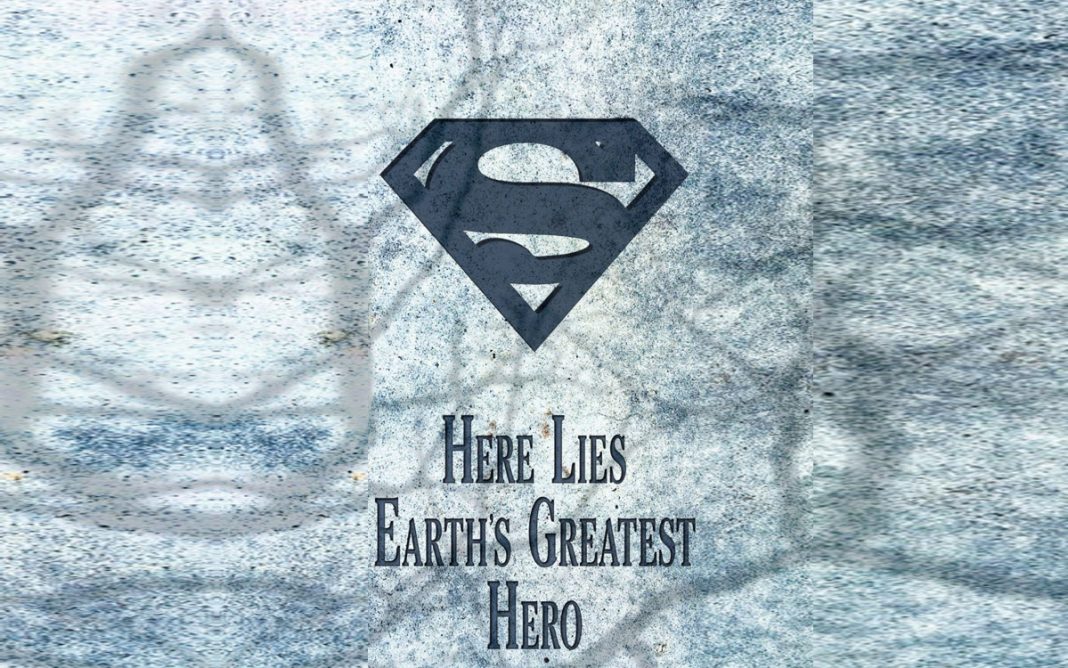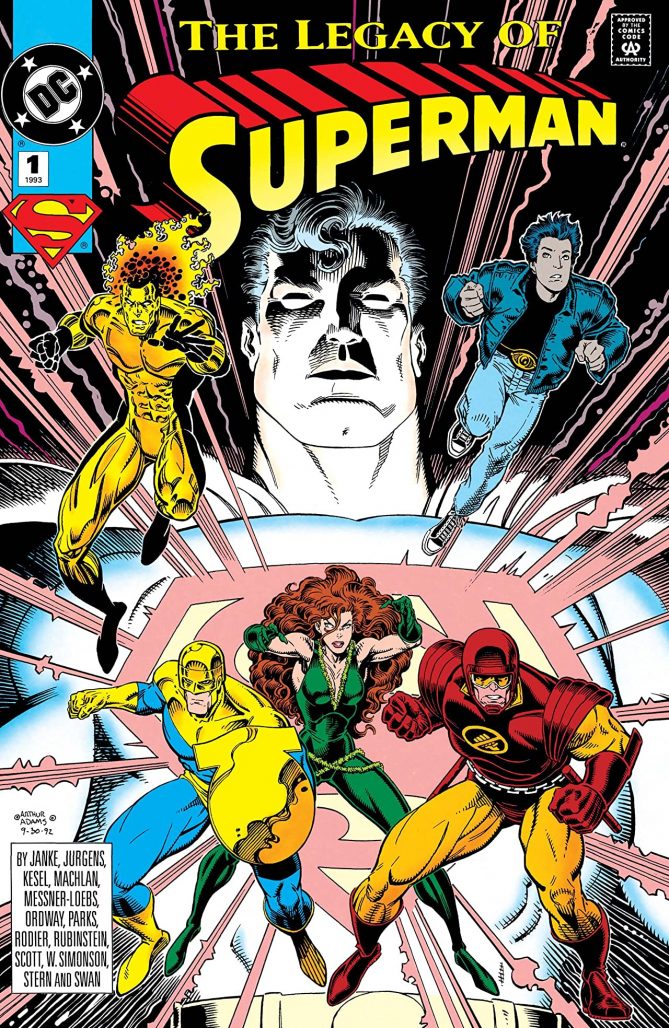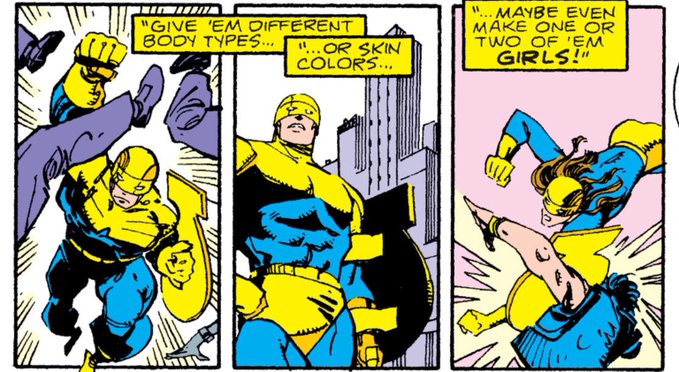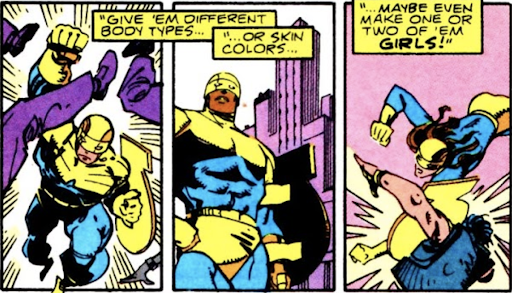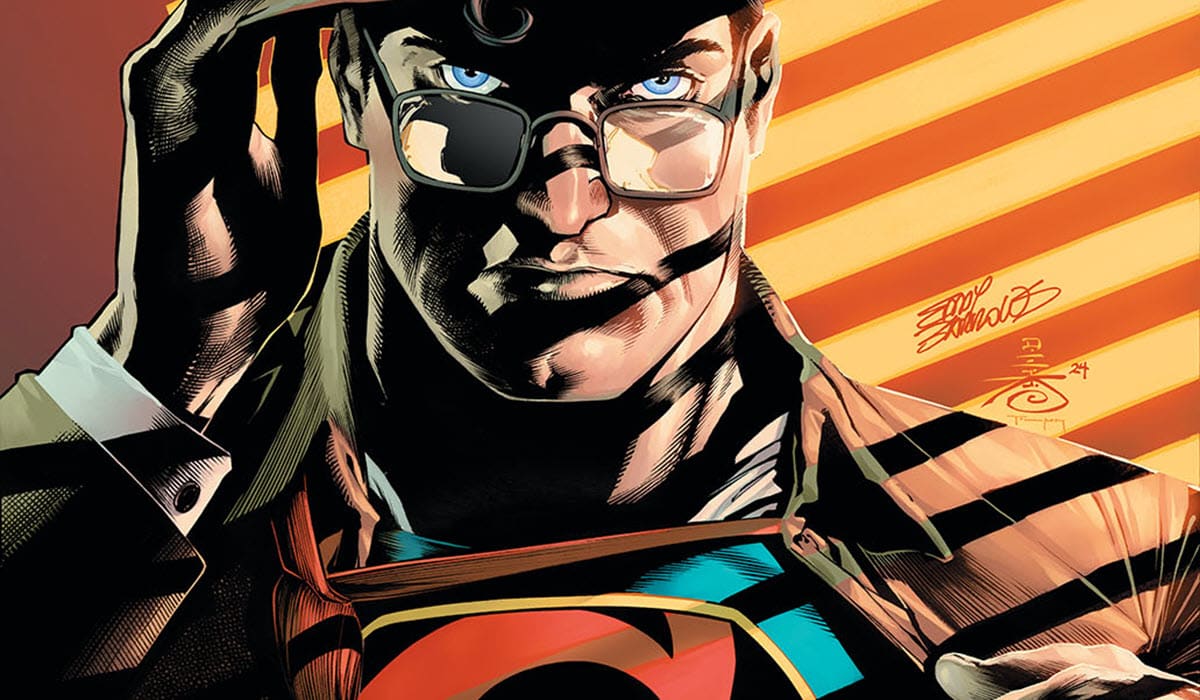There is no information for The Never-Ending Battle at this time. Just kidding, while the Superman line is taking a little break there were a couple of books that came out. The first of those was The Legacy of Superman #1, which focused on the other heroes of Metropolis, and how they coped with the loss of the Man of Steel.
The Legacy of Superman #1
Writers: Karl Kesel, Roger Stern, Jerry Ordway, William Messner-Loebs, and Dan Jurgens
Pencilers: Walt Simonson, Denis Rodier, Dennis Janke, Curt Swan, and Dan Jurgens
Inkers: Walt Simonson, Ande Parks, Mike Machlan, Josef Rubinstein, and Trevor Scott
Colorist: Glenn Whitmore
Letterers: John Workman, Albert De Guzman, John Costanza, and Bill Oakley
Cover Artist: Arthur Adams
The Legacy of Superman is a series of shorter vignettes focussing on the heroes of Metropolis trying to make do in a city that’s lost its most famous and powerful protector. The first is another Karl Kesel penned Cadmus tale, this time drawn by the great Walt Simonson. I remember having this issue when I was younger because even though the price point was higher, my mom was more likely to buy one of the oversized issues than she was a normal-sized comic. This is why when I came across a massive coloring error in the reprint, I immediately remembered that that had not been the case in the newsstand edition. In an idea that hints at what’s to come in the Superman books, Gabby the newsboy talks about how if you make clones of Guardian, they could all be different: body types, skin colors, gender, etc. The problem in the reprint is that the panel where he says “skin colors” is still a Guardian that is very white, when in the original printing it was a Black Guardian.
This is not the first time that digital translations of Glenn Whitmore’s work have resulted in what looks like racism, and it’s vastly disappointing because Whitmore did so much incredible work over the entire decade that having the most accessible versions of his work not actually represent how he had done it is just disheartening (Note: It appears that the digital single issue of The Legacy of Superman does have corrected colors, but the printed trade paperbacks, the two newer omnibuses, and the digital version of the “Funeral for a Friend” trade paperback all have the incorrect coloring, hopefully this will be fixed in the 2022 Omnibus reprint). The Kesel and Simonson Cadmus story introduces all the problems the Cadmus crew are having with trying to clone Superman, and also introduces Auron, a Guardian clone that they have augmented. But because Auron is still a clone of Jim Harper, he makes the ethical decision to not allow Westfield access to Superman’s decoded DNA.
The second story is a Roger Stern and Denis Rodier Thorn story. It’s always interesting to see artists who are primarily known as inkers take a turn at penciling. Rodier’s inking style is a perfect fit for Jackson Guice’s more realistic line work, and here as penciller he follows a similar style, though a little less clean than Guice’s pencils. The action in the Thorn story is pretty simple, run of the mill vigilante stuff. But it continues to expand on the fact that Metropolis keeps falling further and further into criminal activity without the threat of Superman.
Speaking of inkers getting a chance to do pencils, the third story is by Jerry Ordway and Dennis Janke. Similar to how Rodier’s style seems to be similar to the penciler he inks most, so does Janke. His Gangbuster is a bit more stylized, his faces more expressive, closer in tone to Jon Bogdanove than others working on the line at the time. The Gangbuster story is fun and energetic, and a much more entertaining vigilante story than the Thorn one that came before it. The biggest thing this story establishes is that while he’s been working to clean up the streets in Superman’s stead, Gangbuster has been doing so with a bit more excessive force than Metropolis criminals are used to, and some of them are looking to press charges on the vigilante. It’s a nice reminder that Metropolis isn’t Gotham and that vigilante justice is still not legal.
The next story is another example where the digital colors have done a disservice to Glenn Whitmore’s original colors. This is the one that has been most prevalent looking at the recolored trades and digital issues over the years, in that the coloring of Middle-Eastern characters comes out a brownish-grey in the new editions, while in the originals it was much closer to an actual skin tone. The reason that this error is prevalent in this story is that it brings back William Messner-Loebs and Curt Swan to tell another story with their Sinbad character. Davood was created as part of a pre-Triangle Era fill-in arc by Messner-Loebs and Swan, and this is his first (and last) appearance after that arc. Sinbad is a fairly flat character that I wish someone could inject a little more life into to make interesting because he does fill a very real need for representation. But it seems like the only writer that ever remembers that he exists is Messner-Loebs*, and that’s a shame. The other thing that this story drives home is the difference between public perception of the younger Luthor to his behavior behind closed doors. He’s done a lot since coming to Metropolis to establish himself as the new, nicer Luthor; but in private he’s still very much the same mean and spiteful man.
(*Editor’s Note: Another writer, Chris Roberson, also remembered that Davood exists, and tried to bring him back after he took over Superman‘s 2011 “Grounded” storyline; DC cancelled the story after it was solicited, and replaced it with a Krypto inventory tale.)
The last story of the issue is focused on the Linear Men, by Dan Jurgens and Trevor Scott. This is a morality play in which the Linear Men train their newest member, Waverider, on not interfering with how history plays out. The example they use to get this point across is the death of Superman. Matthew Ryder is the one who teaches Waverider that mucking about in time is a slippery slope, and the changes that you make can have disastrous ramifications. It’s a lesson Waverider needed to learn, and this was the most poignant way possible for him to do so.
Miss any previous entries in The Never-Ending Battle? The early entries can be found at Comfort Food Comics, while more recent ones can be found here at The Beat.


